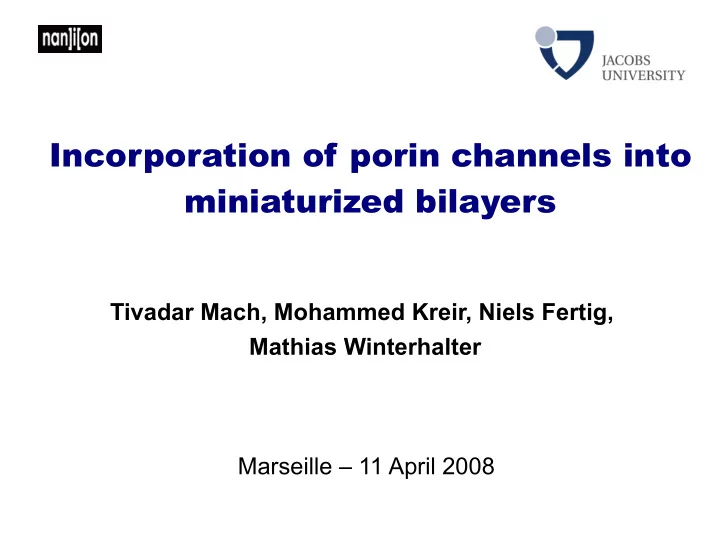

Incorporation of porin channels into miniaturized bilayers Tivadar Mach, Mohammed Kreir, Niels Fertig, Mathias Winterhalter Marseille – 11 April 2008
Folded classical bilayer Main issues: ● time resolution (30-50 μs rock bottom) ● chamber volume (antibiotic concentrations → mM ) ● manual operation
Folded classical bilayer Main issues: ● time resolution (30-50 μs rock bottom) ● chamber volume (antibiotic concentrations → mM ) ● manual operation
Miniaturized bilayer
Insertion of hydrophilic peptides Alpha-Haemolysin hydrophilic, water-soluble 120 current (pA) 80 40 0 5 10 15 20 25 time (s) Small transmembrane domain 0.4 Count (N) Add peptide 0.2 in water solution insertion almost immediate 0 0 20 40 60 80 100 120 Amplitude (pA)
Hydrophobic porins are different ● Membrane proteins with a significant hydrophobic domain denature in pure water solution. ● During extraction & purification, detergent is used. OmpA in detergent micelle and lipid bilayer (courtesy of Dr. J Bond, University Oxford) This can be an advantage! Insertion of proteins in micelles into conventional bilayer by going below the CMC , forcing proteins into BLM.
Insertion from micelles into Montal-Muller BLM OmpA transition from mycelle to bilayer (courtesy of Dr. J Bond, University Oxford) I. Add concentrated micelle solution to II. Micelles III. By applying bilayer chamber. dissociate, leaving voltage and the protein to destabilizing the → Detergent denature, BLM, a tiny portion concentration goes of proteins will aggragate, or far below CMC insert. insert into BLM
Micellar insertion into adsorbed BLM Advantages of micelle-insertion: ● Simple! Protein is usually purified in detergent, no other steps necessary. ● Good control on number of proteins inserted – when destabilizing voltage is stopped, insertions (usually) stop. Sadly, this does not work for the glass-adsorbed bilayer! The glass-adsorbed bilayer immediately breaks on contact with the micelle solution. Controls → detergent sensitive (Down to 1 ppb !)
Alternative insertions into adsorbed BLM Aim: reduce detergent, increase stability. Routes: I. Change lipid composition, pre-dilute protein solution → micellar insertion II. Insert protein into pre-formed GUVs before adsorption, make bilayer with proteo-GUVs III. Insert protein into SUVs, fuse proteo-liposomes to already standing adsorbed bilayer
Adsorption of proteo-GUVs In principle it works: Detergent removal by Biobeads in the native GUV solution OmpF insertion and gating, measured at -150 mV on the Nanion box Can insert OmpF, measure gating of protein. Needed a significant amount of optimization Mohammed
Alternative insertions into adsorbed BLM Aim: reduce detergent, increase stability. Routes: I. Change lipid composition, pre-dilute protein solution → micellar insertion II. Insert protein into pre-formed GUVs before adsorption, make bilayer with proteo-GUVs III. Insert protein into SUVs, fuse proteo-liposomes to already standing adsorbed bilayer
Proteoliposome (SUV) fusion Fusion strategies: I. Ethanolamine-Ethanolamine fusion (Ca 2+ or Mg 2+ mediated) SUV: Bilayer: -PC + 10% -PE √ √ -PC + 10% -PE E.coli polar extract (67% PE) √ √ II. Charge-charge fusion negatively charged SUV coupling to positively charged BLM SUV: Bilayer: -PC + 5% -PS √ √ Stearylamine in -PC E.coli polar extract (23% PG) √ √ bilayer (up to E.coli polar extract (23% PG) + 5% -PS 10-12%). √ √ III. Phosphocolin-Phosphocolin fusion X
Preparation of proteo-SUVs Lipid film → rehydration → sonication (or extrusion) Protein addition after liposome formation (vs. protein addition to lipid film prior to rehydration) → adsorbed BLM found to be more stable → orientation Protein addition Detergent removal Biobeads, 2 exchanges Dialysis
Do we get fusion? -PE -PE fusion +150 mV Charge-charge fusion -150 mV Short answer: yes
A closer look at fusion -75 mV, 150 mM KCl, symmetric salt, DPhPE+DPhPC GUV, DPhPE+DPhPC SUV
A closer look at fusion Counting OmpF insertions +75 mV, 150 mM KCl, symmetric salt, DPhPE+DPhPC GUV, DPhPE+DPhPC SUV
Controls – insertion by liposome fusion Tests whether protein insertion actually occurred by fusion: I. Same treatment of protein solution without liposomes results in no insertions . II. Increases in conductance are quantized by protein content of liposomes, dependent on initial protein concentration. OmpF trimer Lipid / Approx. OmpF / concentration OmpF trimer liposome 0.084 μM 118000 0.5 0.166 μM 59000 1 0.326 μM 29500 3 0.770 μM 11800 7 1.412 μM 5900 14
Number of OmpF trimers per insertion (normalized) 0.08 uM 0.166 uM 0.33 uM “1” “1” “1” “2” “2” “2” “3” “3” “3” “4” “4” “4” “5” “5” “5” “6” “6” “6” “7” “7” “7” “8” “8” “8” “9” “9” “9” “10” “10” “10” 0 5 10 15 20 25 0 5 10 15 20 25 30 35 0 5 10 15 20 25 30 35 0.77 uM 1.4 uM “1” “1” “2” “2” “3” “3” “4” “4” “5” “5” “6” “6” “7” “7” “8” “8” “9” “9” “10” “10” 0 5 10 15 20 25 0 5 10 15 20 25 30 35 40 45
Possible to keep the number of insertions constant ● Rapid perfusion ● EDTA ● Extreme dilution
Our version with microfluidic access (perfusion)
Comparison et al. DPhPC + 10 mol DPhPC + 10 mol E. coli polar DPhPC % DPhPS % DPhPE extract DPhPC – – – – DPhPC + 10 mol% conc n gradient – conc n gradient – stearylamine DPhPC + 5 mol% conc n gradient conc n gradient – – DPhPE + Ca 2+ / Mg 2+ + Ca 2+ / Mg 2+ Proteo-GUV Liposome fusion Lipid composition positive / neutral almost any Storable 3-5 days Proteo-SUVs: frozen few months Automation Easy ? Single-channel insertion Easy (calibrate concentrations) Serious problem (need perfusion) Unknown channel “patch-clamp” – channel inserted from start Gradual (“quantized”) insertion, fast steps Protein consumption Small for one experiment – large for series Enormous (compared to BLM) Almost any Buffer composition Buffer matters (Ca 2+ / Mg 2+ for PE fusion, can be perfused)
Alternative insertions into adsorbed BLM Aim: reduce detergent, increase stability. Routes: I. Change lipid composition, pre-dilute protein solution → micellar insertion II. Insert protein into pre-formed GUVs before adsorption, make bilayer with proteo-GUVs III. Insert protein into SUVs, fuse proteo-liposomes to already standing adsorbed bilayer
Recommend
More recommend